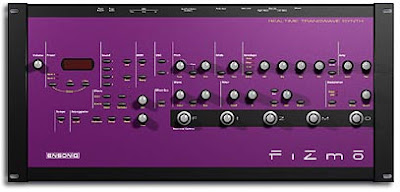
This purple artifact is the strange Ensoniq Fizmo, one of the synthesizers that more track have left on me of whatever has passed through my hands.
Keyboard version came out to the market in 1998 (99 for the rack) and, as soon as it counted a year of life, the Ensoniq company was absorbed by EMU (that later ate Creative). Fizmo received very bad critics after many expectations by its look: in the heat of VA (Virtual Analogics) synths, everybody expected an aggressive vintage tone when, in fact, it had a pure digital character, even lo-fi. Another one of its weak points was an operating system full of errors, reflection (I suspect) of the haste and the final days of a company that left it without completing. To make it worse, it came wrapped by a very small display with very cryptic details from the editable parameters, many of which, in addition, were not accessible without a software editor produced later. So it was not a big hit, and its production is expected around 500 units for the keyboard version and 50 for the rack unit.
The worse fact is that the synth counted on a big serious technical failure. Apparently it has a voltage regulator that could fail which can burn the motherboard, thing that happened to some users, which makes people think that less than half which were produced still working nowadays. With Ensoniq disappeared, while EMU and Creative keep away from that problem, were users in last instance that have found a solution.
Even with that, Fizmo has reached a cult synthesizers state (at least for an eclectic minority of users), not only by the challenge to find one, but by the sound that is able to produce and the high skills needed to fully dominate it because the parameters hidden on strange acronyms or simply being not accessible without a software editor. That kind of things that could be fun for some of us...

About the sound, nothing that relates it to VA or workstations, that is to say, not useful neither to imitate vintage sounds nor realistic pianos nor trumpets. Neither useful to design great bass sounds or drums, so, what is it useful then? I remember somebody in a forum once said he used this instrument not to make music, but like inspiration source machine. And it has his logic. Away from pure electronic, most of the sounds that are able to produce this synth are atmospheric or noisy, leaning in an evolutionary process based on transwaves (wave tables, some very strange), making it working like the Korg Wavestation or the Waldorf Wave, which is wonderful to create impossible sounds and to generate strange pads and textures.
In addition, one of the most interesting things of this synth are the mysterious five F, I, Z, M, O knobs that respond to who_knows_what parameters depending on preset selected, which confers additional fun when it gives a deep element of random touch to each sound.
Some sounds of example here
Other interesting links here, here and here
Technical specifications:
- Polyphony - 48 voices
- Oscilators - 4 MB of 16-bit internal wave ROM, featuring Transwaves (created through digital synthesis and resynthesis technologies); 2 osc for each of 4 presets - total of 8 simultaneous - 58 waveforms
- LFO Time - 8 LFO's (7 waveform choices, can sync to Arpeggiator or external MIDI clock)
- Filters - Resonant LP & BP 4 pole filters. Non-Resonant 2LP+2HP, 3LP+1HP, 2LP+2LP, 3LP+1HP filters.
- Efects - 41 digital VLSI 24-bit effects (8 Global Reverbs, Chorus, Flanger, DDL, Distortion, Tunable Speaker, Chatter Box, Vocal Morph, Auto-Wah, Vocoder); Processes incoming audio
- Keyboard - 61 semi-weighted keys (velocity and channel pressure sensitive, 4 programmable key ranges, 4 possible zones)
- Memory - 128 ROM sounds, Up to 128 RAM, 64 Presets
- Control - MIDI (up to 4 polyphonic channels)
- Production data - 1998
No hay comentarios:
Publicar un comentario